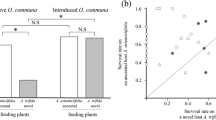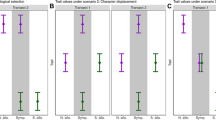Abstract
Understanding the drivers of trade-offs among traits is vital for comprehending the evolution and maintenance of trait variation. Theoretical frameworks propose that evolutionary mechanisms governing trade-offs frequently exhibit a scale-dependent nature. However, empirical tests of whether trade-offs exhibited across various biological scales (i.e. individuals, populations, species, genera, etc.) remains scarce. In this study, we explore trade-off between dispersal and reproductive effort among sympatric sister species of wasps in the genus Belonocnema (Hymenoptera: Cynipini: Cynipidae) that form galls on live oaks: B. fossoria, which specializes on Quercus geminata, and B. treatae, which specializes on Q. virginiana. Specifically, our results suggest that B. fossoria has evolved reduced flight capability and smaller wings, but a larger abdomen and greater total reproductive effort than B. treatae, which has larger wings and is a stronger flier, but has a smaller abdomen and reduced total reproductive effort. These traits and the relationships among them remain unchanged when B. fossoria and B. treatae are transplanted and reared onto the alternative host plant, suggesting that trait divergence is genetically based as opposed to being a plastic response to the different rearing environments. However, when looking within species, we found no evidence of intraspecific trade-offs between wing length and reproductive traits within either B. fossoria or B. treatae. Overall, our results indicate that observed trade-offs in life history traits between the two gall former species are likely a result of independent adaptations in response to different environments as opposed to the amplified expression of within species intrinsic tradeoffs.







Similar content being viewed by others
Data availability
Data and r code can be found here: https://zenodo.org/doi/10.5281/zenodo.10620589.
References
Agrawal AA (2020) A scale-dependent framework for trade-offs, syndromes, and specialization in organismal biology. Ecology 101:e02924
Bolnick DI, Svanbäck R, Fordyce JA, Yang LH, Davis JM, Hulsey CD, Forister ML (2003) The ecology of individuals: incidence and implications of individual specialization. Am Nat 161:1–28
Bonnet X, Lourdais O, Shine R, Naulleau G (2002) Reproduction in a typical capital breeder: costs, currencies, and complications in the Aspic viper. Ecology 83:2124–2135
Brandão-Dias PFP, Zhang YM, Pirro S, Vinson CC, Weinersmith KL, Ward AKG, Forbes AA, Egan SP (2022) Describing biodiversity in the genomics era: a new species of Nearctic Cynipidae gall wasp and its genome. Syst Entomol 47:94–112
Carroll SP, Marler M, Winchell R, Dingle H (2003) Evolution of cryptic flight morph and life history differences during host race radiation in the soapberry bug, Jadera haematoloma Herrich-Schaeffer (Hemiptera: Rhopalidae). Ann Entomol Soc Am 96:135–143
Cavender-Bares J, Pahlich A (2009) Molecular, morphological, and ecological niche differentiation of sympatric sister oak species, Quercus virginiana and Q. geminata (Fagaceae). Am J Bot 96:1690–1702
Cavender-Bares J, González-Rodríguez A, Eaton DAR, Hipp AAL, Beulke A, Manos PS (2015) Phylogeny and biogeography of the American live oaks (Quercus subsection Virentes): a genomic and population genetics approach. Mol Ecol 24:3668–3687
Dell’Aglio DD, Mena S, Mauxion R, McMillan WO, Montgomery SH (2022) Divergence in Heliconius flight behaviour is associated with local adaptation to different forest structures. J Anim Ecol 91:727–737
Denno RF, Roderick GK, Peterson MA, Huberty AF, Dobel HG, Eubanks MD, Losey JE, Langellotto GA (1996) Habitat persistence underlies intraspecific variation in the dispersal strategies of planthoppers. Ecol Monogr 66:389–408
Driscoe AL, Nice CC, Busbee RW, Hood GR, Egan SP, Ott JR (2019) Host plant associations and geography interact to shape diversification in a specialist insect herbivore. Mol Ecol 28:4197–4211
Duthie AB, Abbott KC, Nason JD (2015) Trade-offs and coexistence in fluctuating environments: evidence for a key dispersal-fecundity trade-off in five nonpollinating fig wasps. Am Nat 186:151–158
Egan SP, Hood GR, Feder JL, Ott JR (2012a) Divergent host-plant use promotes reproductive isolation among cynipid gall wasp populations. Biol Lett 8:605–608
Egan SP, Hood GR, Ott JR (2012b) Testing the role of habitat isolation among ecologically divergent gall wasp populations. Int J Ecol 2012:1–8
Egan SP, Hood GR, DeVela G, Ott JR (2013) Parallel patterns of morphological and behavioral variation among host-associated populations of two gall wasp species. PLoS ONE 8:e54690
Falconer DS (1981) Introduction to quantitative genetics, 2nd edn. Longman Group Ltd., London, pp 1–133
Futuyma DJ, Moreno G (1988) The evolution of ecological specialization. Annu Rev Ecol Syst 19:207–233
Ghalambor CK, Reznick DN, Walker JA (2004) Constraints on adaptive evolution: the functional trade-off between reproduction and fast-start swimming performance in the Trinidadian guppy (Poecilia reticulata). Am Nat 164:38–50
Gotthard K (2000) Increased risk of predation as a cost of high growth rate: an experimental test in a butterfly. J Anim Ecol 69:896–902
Guerra PA (2011) Evaluating the life-history trade-off between dispersal capability and reproduction in wing dimorphic insects: a meta-analysis. Biol Rev 86:813–835
Hahn PG, Maron JL (2016) A framework for predicting intraspecific variation in plant defense. Trends Ecol Evol 31:646–656
Honěk A (1993) Intraspecific variation in body size and fecundity in insects: a general relationship. Oikos 66:483–492
Hood GR, Ott JR (2011) Generational shape shifting: changes in egg shape and size between sexual and asexual generations of a cyclically parthenogenic gall former. Entomol Exp Appl 141:88–96
Hood GR, Ott JR (2017) Independent life history evolution between generations of bivoltine species: a case study of cyclical parthenogenesis. Oecologia 183:1053–1064
Hood GR, Zhang L, Hu EG, Ott JR, Egan SP (2019) Cascading reproductive isolation: plant phenology drives temporal isolation among populations of a host-specific herbivore. Evolution 73:554–568
King EG, Roff DA, Fairbairn DJ (2011) Trade-off acquisition and allocation in Gryllus firmus: a test of the Y model. J Evol Biol 24:256–264
Lund JN, Ott JR, Lyon RJ (1998) Heterogony in Belenocnema treatae Mayr (Hymenoptera: Cynipidae). Proceedings-Entomological Society of Washington 100:755–763. Entomological Society of Washington.
Nasu S, Tokuda M (2021) Dispersal–reproduction trade-off in the leaf beetle Galerucella grisescens. Entomol Exp Appl 169:542–549
Reznick DN, Bryga H (1987) Life-history evolution in guppies (Poecilia reticulata): 1. Phenotypic and genetic changes in an introduction experiment. Evolution 41:1370–1385
Roff DA (1986) The Evolution of Wing Dimorphism in Insects. Evolution 40:1009–1020
Roff DA (1990) The evolution of flightlessness in insects. Ecol Monogr 60:389–421
Roff DA, Mostowy S, Fairbairn DJ (2002) The evolution of trade-offs: testing predictions on response to selection and environmental variation. Evolution 56:84–95
Rogers LE, Hinds WT, Buschbom RL (1976) A general weight vs. length relationship for insects. Ann Entomol Soc Am 69:387–389
Sargent RD, Goodwillie C, Kalisz S, Ree RH (2007) Phylogenetic evidence for a flower size and number trade-off. Am J Bot 94:2059–2062
Stevens VM, Trochet A, Blanchet S, Moulherat S, Clobert J, Baguette M (2013) Dispersal syndromes and the use of life-histories to predict dispersal. Evol Appl 6:630–642
Tigreros N, Davidowitz G (2019) Chapter one—Flight-fecundity tradeoffs in wing-monomorphic insects. In Jurenka R (ed) Advances in insect physiology. Academic Press, pp. 1–41
van Noordwijk AJ, de Jong G (1986) Acquisition and allocation of resources: their influence on variation in life history tactics. Am Nat 128:137–142
Vorburger C (2005) Positive genetic correlations among major life-history traits related to ecological success in the aphid Myzus perisicae. Evolution 59:1006–1015
Worley AC, Baker AM, Thompson JD, Barrett SC (2000) Floral display in Narcissus: variation in flower size and number at the species, population, and individual levels. Int J Plant Sci 161:69–79
Zera AJ, Denno RF (1997) Physiology and ecology of dispersal polymorphism in insects. Annu Rev Entomol 42:207–230
Zera AJ, Harshman LG (2001) The physiology of life history trade-offs in animals. Annu Rev Ecol Syst 32:95–126
Zera AJ, Rankin MA (1989) Wing dimorphism in Gryllus rubens: genetic basis of morph determination and fertility differences between morphs. Oecologia 80:249–255
Zhang L, Driscoe A, Izen R, Toussaint C, Ott JR, Egan SP (2017) Immigrant inviability promotes reproductive isolation among host-associated populations of the gall wasp Belonocnema treatae. Entomol Exp Appl 162:379–388
Zhang L, Hood GR, Carroo I, Ott JR, Egan SP (2021a) Context-dependent reproductive isolation: host plant variability drives fitness of hybrid herbivores. Am Nat 197:732–739
Zhang L, Hood GR, Roush AM, Shzu SA, Comerford MS, Ott JR, Egan SP (2021b) Asymmetric, but opposing reductions in immigrant viability and fecundity promote reproductive isolation among host-associated populations of an insect herbivore. Evolution 75:476–489
Zhang YM, Egan SP, Driscoe AL, Ott JR (2021c) One hundred and sixty years of taxonomic confusion resolved: Belonocnema (Hymenoptera: Cynipidae: Cynipini) gall wasps associated with live oaks in the USA. Zool J Linn Soc. https://doi.org/10.1093/zoolinnean/zlab001
Zhang L, Mullin BF, Shzu S, Davis CK, Hu EG, Carroo IJ, Egan SP (2022) Parallel host-plant-associated differences in an extended phenotype between populations of six species of gall-forming insects. Ecol Entomol 47:323–330
Zhang L, Hood GR, Ott JR, Egan SP (2019) Temporal isolation between sympatric host plants cascades across multiple trophic levels of host-associated insects. Biol Lett 15:20190572. Royal Society.
Acknowledgements
We thank Elaine Hu, Isaac Carroo and Hannah Towbin for assistance with sample collection and morphological measurements. Funding was provided to AMR by the Spurlino Summer Undergraduate Research Fellowship, to LZ by student research award from Society for Integrative and Comparative Biology, Rosemary Grant Award from the Society for the Study of Evolution, and the Diana McSherry and Patrick Poe research award, to SPE from the Department of BioSciences at Rice University and to GRH from the Rice University Academy of Fellows.
Author information
Authors and Affiliations
Contributions
LZ, SPE, GRH, and JRO conceived and designed the study. AMR collected the data, AMR and LZ analyzed the data. AMR and LZ wrote the manuscript with subsequent inputs from all authors.
Corresponding author
Additional information
Communicated by Kyle J Haynes.
Supplementary Information
Below is the link to the electronic supplementary material.
Rights and permissions
Springer Nature or its licensor (e.g. a society or other partner) holds exclusive rights to this article under a publishing agreement with the author(s) or other rightsholder(s); author self-archiving of the accepted manuscript version of this article is solely governed by the terms of such publishing agreement and applicable law.
About this article
Cite this article
Roush, A.M., Zhang, L., Hood, G.R. et al. A test of trade-offs in dispersal and reproduction within and between a sister species pair of specialist insect herbivores. Oecologia 204, 529–542 (2024). https://doi.org/10.1007/s00442-024-05512-3
Received:
Accepted:
Published:
Issue Date:
DOI: https://doi.org/10.1007/s00442-024-05512-3




